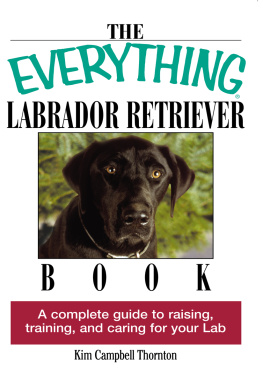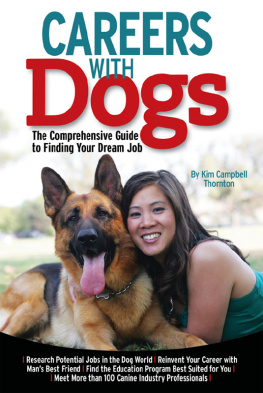Susan Chaney, Consulting Editor
Copyright 2006, 2009 by I-5 Press
Illustrations copyright 2006 by Buck Jones
The dogs in this book are referred to as he and she in alternating chapters.
All rights reserved. No part of this book may be reproduced, stored in a retrieval system, or transmitted in any form by any means, electronic, mechanical, photocopying, recording, or otherwise, without the prior written permission of I-5 Press, except for the inclusion of brief quotations in an acknowledged review.
Library of Congress-in-Publication Data
Thornton, Kim Campbell.
Senior dogs / by Kim Campbell Thornton ; illustrations by Buck Jones.
p. cm. (Simple solutions)
ISBN 1-931993-72-6
eISBN: 9781620080764
1. Dogs. 2. DogsAging. 3. DogsHealth. 4. DogsDiseases. 5. Veterinary geriatrics. I. Title. II. Series: Simple solutions (Irvine, Calif.)
SF427.T493 2006
636.7'089'897dc22
2005016365
I-5 Press
A Division of I-5 Publishing, LLC
3 Burroughs
Irvine, California 92618
Printed and bound in China
10 9 8 7 6 5 4 3 2
Contents
When Is a Dog Old?
Aging occurs when the body starts to deteriorate faster than it can regenerate. Some of us can recall when it started happening to our bodies. Our memories became less sharp and our bodies became more prone to soreness and stiffness after exertion. The same thing happens to our dogs as they age. Dogs age at different rates, depending on their breed, their size, and the simple luck of the genetic draw. For instance, large dogs tend to age more rapidly than do small dogs; flat-faced breeds tend to age more rapidly than do dogs with longer muzzles. Some dogs just have good genes when it comes to longevity, no matter what their breed or size. In general, though, a dog enters her senior years at age seven or eight. Giant breeds typically begin aging a little earlier, achieving senior status at five or six years. Toy breeds age a little later than average, entering their golden years at approximately nine or ten years.

Fortunately for dogs (and for the people who love them), advances in veterinary medicine and canine nutrition have greatly increased the canine life span; senior diets, new medications, and ramps and other aids are available to improve their health and comfort. With lots of love and good care, dogs can live into their mid-teens, with a rare few reaching advanced ages of eighteen or nineteen years.

How do you know if your dog is starting to feel the effects of age? Youll probably notice that she moves a little more slowly when she gets up from a nap. The dog who once walked with a spring in her step now moves at a sedate stroll. Her muzzle is gray and her eyebrows sprout white hairs. She may gain or lose weight. Ask yourself the following questions:
Is my dog drinking more water than usual?
Has she recently gained or lost 10 percent or more of her body weight?
Has her appetite increased or decreased significantly?
Is her coat or skin dry, dull, or flaky?
Does she have less energy or stamina than usual?
Does she have accidents in the house for no apparent reason?
If the answer is yes to one or more of these questions, its time to make an appointment with your veterinarian for a golden-age checkup.
The Geriatric Exam
The golden years make up between 30 and 40 percent of a dogs life. During these years, a dogs body is constantly changing; his metabolism slows and he may develop health problems that require you to adjust his diet and exercise in order for him to remain healthy. Dog owners can sense some changes just by observing their pets. However, aging animals have many internal changes that could lead to health problems that can be detected only by a professional through a physical examination and lab work. Nonetheless, only about 14 percent of senior animals get regular health screenings as recommended by their veterinarians. Thats a shame, because preventive care can not only extend your dogs life but also help reduce your veterinary expenses because youre more likely to catch health problems before they take a bite out of your wallet.

When your dog starts getting on in years, even if he appears to be healthy, take him to the veterinarian for a geriatric checkup. This physical exam and the accompanying lab work will establish your dogs current health status, a baseline against which he can be judged as he continues to age. A semiyearly checkup can uncover health problems, such as tumors or dental disease, when theyre easier and less expensive to treat. A thorough geriatric exam includes a complete physical, lab tests, and an interview with your veterinarian about your dogs lifestyle.
Before you head to the clinic, you should prepare for the exam. The veterinarian will want to know about your dogs habits, environment, and diet. Be prepared to tell her how often your dog goes for walks or gets exercise, how much and what type of food he eats, and what treats he gets. Discuss your dogs behavioral changes, such as sleeping more or less or being more or less friendly toward friends or strangers. Inspect your dogs body for lumps or other issues such as skin irritations, and check to see whether he has a limp. Its a good idea to take notes and to make a list of questions so you dont forget anything. The information you gather will help give your veterinarian a complete picture of your dogs health.

At the clinic, your veterinarian may start the exam by observing your dog as he walks. This allows her to evaluate the way he moves, his apparent comfort level, and his overall body condition. Shell also check the dogs vital signstemperature, heart rate and rhythm, and respirationas well as his weight, reflexes, and hydration level. Shell run her hands over his abdomen to check the size and shape of the kidneys and liver. Shell feel for lumps on his body and search for signs of problems such as enlarged lymph glands or a subtle flinch that indicates pain. Shell test his range of motion by moving and bending his legs. The exam also includes vision and hearing checks; an evaluation of his coat, skin, toenails, and nail beds; and a look inside the mouth to see if he has bad breath, tartar on the teeth, or sores in the oral cavity.

Lab work may include a complete blood count (CBC), urinalysis, and fecal exam. Additional blood work will test such things as your dogs levels of blood urea nitrate (BUN) and creatinine, which are important in determining kidney health; glucose, high levels of which can indicate diabetes; and albumin, alkaline phosphatase, and bilirubin, which are indicators of liver function. Depending on your dogs medical history and the results of the exam and lab work, your veterinarian may also recommend diagnostic tests such as radiographs (X rays); an echocardiogram and an electrocardiogram (ECG or EKG) to assess heart function; a tear test for dry eye; or tonometry, a procedure that measures eye pressure and can indicate the presence of glaucoma (abnormally high eye pressure that could lead to blindness).
Next page



















